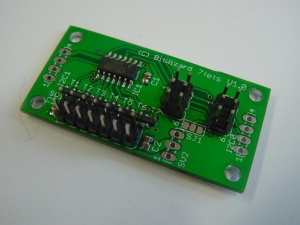Difference between revisions of "7FETs"
| Line 13: | Line 13: | ||
== Assembly instructions == |
== Assembly instructions == |
||
None the board comes assembled. |
|||
== Specifications == |
== Specifications == |
||
Revision as of 19:33, 7 March 2012
This is the documentation page for the SPI_7FETs board.
Overview
The board has 7 fets that allow you to pull a pin of a load low. You would normally tie the other end of your load directly to the powersupply.
About 1A per output should be possible. Maximum voltage is 20V.
You will have to provide your own protection circuits if you are going to drive inductive loads (like a motor).
Assembly instructions
None the board comes assembled.
Specifications
The 7fets board is capable of sinking about 1A per output. We have tested 1.25A and the fet became slightly warm, as predicted by theory.
Although the specifications for the fets allow a larger current, it is not recommended to exceed the 1A as the contacts of the connectors are not rated for so much, also the PCB is not equipped for such large currents. But if you need to drive several loads in sequence 1A per port is comfortably possible.
Possible Configurations
External resources
Datasheets
the fets: [[1]]
Additional software
Related projects
Pinout
LEDs
Power connector
The connector SV2 allows you to connect the "powersource".
You can chose two configurations: You can use pin 1-2 as ground and power. You can connect up to 15V (*) to pin 2 referenced to GND on pin 1.
(*) The datasheet for the used transistors mentions "20V", but is is always prudent to keep some margin.
If you want 5V as the powersource, you could put a jumper on pin 2-3. In that case you will have to be aware that you're using the 5V power from the rest of the system. This will be limited by e.g. USB power limits, other devices on the SPI bus, cable thickness and connector capability. But for low-current 5V applications this might be useful.
jumper settings
See solder jumpers on how to change the solder jumper.
By changing the solder jumper SJ1, you can make the connector nearest the board edge into the ICSP programming connector for the attiny44 on the board.
Protocol
To make the 7fets PCB do things, you need to send things over the SPI bus to the PCB.
The general overview of the protocol is here.
The specific commands for the 7fets PCB are explained on the page about the spi_dio board, as the two boards share the same protocol: spi_dio_protocol . Where the SPI_DIO drives an output high, the 7fets board will drive the output pin LOW when the pin is driven active.
For arduino, a sample PDE is available, called ardemo_lcd.pde, also at BitWizard software download directory .
This is a demo to send things using SPI to the lcd board. The SPI routines there are applicable for the dio and 7fets boards as well.
The software
Default operation
Future hardware enhancements
Future software enhancements
TODO: write a library to make handling this board easy.
Changelog
1.0
- Initial public release
